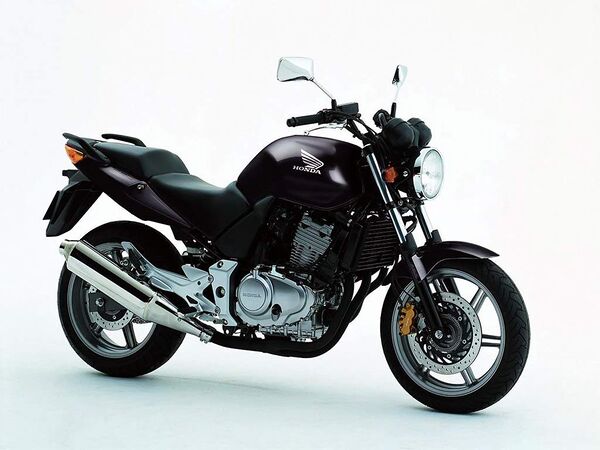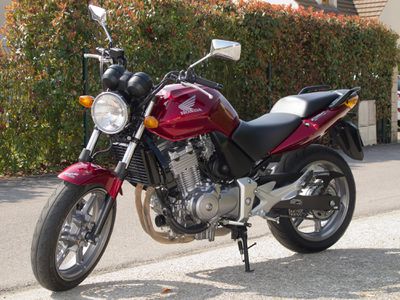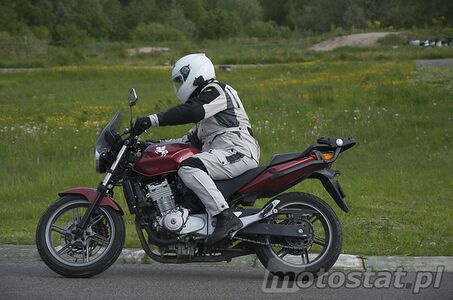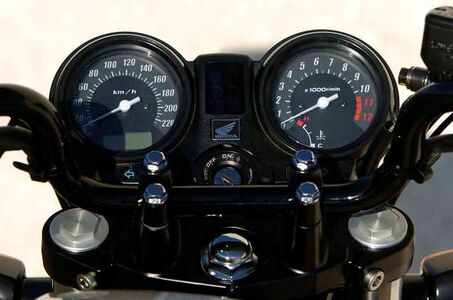Difference between revisions of "Honda CBF500"
m |
m (→Photos) |
||
| (9 intermediate revisions by the same user not shown) | |||
| Line 1: | Line 1: | ||
| − | {{DISPLAYTITLE:Honda | + | {{DISPLAYTITLE: Honda CBF500}} |
| − | |||
{{#seo: | {{#seo: | ||
| − | |keywords= | + | |keywords={{PAGENAME}}, review, specs, owners manual, service manual, guide |
| + | |og:image=https://en.enduro.team/images/1/11/Honda_CBF500.jpg | ||
}} | }} | ||
__notoc__ | __notoc__ | ||
| − | + | [[File: Honda_CBF500.jpg | center | 600px]] | |
| − | + | The naked model '''Honda CBF 500''' appeared in 2004 as a successor of the model [[Honda_CB500 | Honda CB 500]], which, due to the renewal of environmental standards to Euro-2, could no longer be sold on the European market. | |
| − | + | {{Ads_top}} | |
| − | + | Simultaneously with the Honda CBF500, the 4-cylinder model [[Honda_CBF600 | Honda CBF 600]] appeared, which gained significantly more popularity, finally displacing the CBF500 by 2008. In addition, from January 1, 2008, new Euro-3 environmental standards came into force, which CBF500 did not meet. Thus, the Honda CBF 500 model was produced for only 2 years, in 2004 and 2006, and was officially sold until 2008. | |
| − | |||
| − | |||
| − | + | ''' Main competitors: ''' | |
| + | * [[Kawasaki_ER-5 | Kawasaki ER-5]] | ||
| + | * [[Suzuki_GS500 | Suzuki GS 500]] | ||
| + | * [[Suzuki_SV400 | Suzuki SV 400]] | ||
| − | + | Unlike its predecessor ([[Honda_CB500 | Honda CB500]]), the new Honda CBF500 has received a number of technical and visual changes: | |
| − | |||
| − | |||
| − | |||
| − | |||
| − | + | * '''Appearance'''. The model gets a more modern design, a digital odometer dashboard and standard wheel dimensions (120 and 160 mm wide front and rear, respectively). | |
| + | * '''Frame'''. The main difference from its predecessor is the use of the engine as a load-bearing element. | ||
| + | * '''Brake system'''. The main thing here is the availability of versions with a combined braking system + ABS. Visually distinguished by the gold-colored 3-piston front caliper and the presence of the letter A in the name - '' Honda CBF500A ''. | ||
| + | * '''Pendants'''. The model gets a new front fork with a 41 mm diameter stays and a central shock absorber (instead of dual shock absorbers on the sides), which has a 7-step preload adjustment. | ||
| + | * '''Fuel tank'''. The maximum capacity has been increased from 18 to 19 liters. | ||
| − | + | In terms of engine and gearbox, the new Honda CBF500 model is practically no different from the old one - [[Honda_CB500 | Honda CB500]]. Also noteworthy is the fact that the CBF500 was only available in one classic version, while the half fairing version was never offered. | |
| − | |||
| − | |||
| − | |||
| − | == | + | == Photos == |
| − | + | <gallery mode="packed" heights=200px> | |
| − | + | File:Honda-cbf-500 921.jpg| | |
| − | + | File:Honda-cbf500-4.jpg| | |
| − | + | File:0240569490-44.jpg| | |
| − | + | File:02honda-cbf500.jpg| | |
| − | + | </gallery> | |
| − | + | {{Ads_feed}} | |
| + | {{ads_post}} | ||
| − | == | + | == Specifications == |
| − | + | Specifications Honda CBF 500: | |
| − | {| class="wikitable" | + | {| class = "wikitable" |
| − | ! scope="row"| | + | ! scope = "row" | Model |
| − | |Honda CBF 500 | + | | Honda CBF 500 |
|- | |- | ||
| − | ! scope="row"| | + | ! scope = "row" | Motorcycle type |
| − | | | + | | naked |
|- | |- | ||
| − | ! scope="row"| | + | ! scope = "row" | Release year |
| − | |2004-2007 | + | | 2004-2007 |
|- | |- | ||
| − | ! scope="row"| | + | ! scope = "row" | Frame |
| − | | | + | | steel space |
|- | |- | ||
| − | ! scope="row"| | + | ! scope = "row" | Engine type |
| − | |2- | + | | 2-cylinder, 4-stroke, in-line |
|- | |- | ||
| − | ! scope="row"| | + | ! scope = "row" | Working volume |
| − | |499 | + | | 499 cc cm. |
|- | |- | ||
| − | ! scope="row"| | + | ! scope = "row" | Bore / stroke |
| − | |73 | + | | 73.0mm x 59.6mm |
|- | |- | ||
| − | ! scope="row"| | + | ! scope = "row" | Compression ratio |
| − | |10 | + | | 10.5: 1 |
|- | |- | ||
| − | ! scope="row"| | + | ! scope = "row" | Cooling |
| − | | | + | | liquid |
|- | |- | ||
| − | ! scope="row"| | + | ! scope = "row" | Number of valves per cylinder |
| − | |DOHC, 4 | + | | DOHC, 4 valves per cylinder |
|- | |- | ||
| − | ! scope="row"| | + | ! scope = "row" | Fuel supply system |
| − | | | + | | carburetor, 2x Keihin CV, 34mm |
|- | |- | ||
| − | ! scope="row"| | + | ! scope = "row" | Ignition type |
| − | | | + | | fully transistor |
|- | |- | ||
| − | ! scope="row"| | + | ! scope = "row" | Maximum power |
| − | |57 | + | | 57 hp (42 kW) at 9500 rpm |
|- | |- | ||
| − | ! scope="row"| | + | ! scope = "row" | Maximum torque |
| − | |45 | + | | 45 Nm (4.6 kgm) at 8000 rpm |
|- | |- | ||
| − | ! scope="row"| | + | ! scope = "row" | Gearbox |
| − | |6- | + | | 6-speed |
|- | |- | ||
| − | ! scope="row"| | + | ! scope = "row" | Drive type |
| − | | | + | | chain |
|- | |- | ||
| − | ! scope="row"| | + | ! scope = "row" | Front tire size |
| − | |120/70ZR17M/C (58W) | + | | 120 / 70ZR17M / C (58W) |
|- | |- | ||
| − | ! scope="row"| | + | ! scope = "row" | Rear tire size |
| − | |160/60ZR17M/C (69W) | + | | 160 / 60ZR17M / C (69W) |
|- | |- | ||
| − | ! scope="row"| | + | ! scope = "row" | Front brakes |
| − | |1 | + | | 1 disc 296 mm, 2-piston caliper (CBF500A - C-ABS) |
|- | |- | ||
| − | ! scope="row"| | + | ! scope = "row" | Rear brakes |
| − | |1 | + | | 1 disc 240mm, 1-piston caliper (CBF500A - C-ABS) |
|- | |- | ||
| − | ! scope="row"| | + | ! scope = "row" | Front suspension |
| − | | | + | | 41mm telescopic fork, 120mm travel |
|- | |- | ||
| − | ! scope="row"| | + | ! scope = "row" | Rear suspension |
| − | | | + | | monoshock with Pro-Link progression (preload adjustment), stroke - 125 mm |
|- | |- | ||
| − | ! scope="row"| | + | ! scope = "row" | Length |
| − | |2159 | + | | 2159 mm |
|- | |- | ||
| − | ! scope="row"| | + | ! scope = "row" | Width |
| − | |768 | + | | 768 mm |
|- | |- | ||
| − | ! scope="row"| | + | ! scope = "row" | Height |
| − | |1108 | + | | 1108 mm |
|- | |- | ||
| − | ! scope="row"| | + | ! scope = "row" | Wheelbase |
| − | |1480 | + | | 1480 mm |
|- | |- | ||
| − | ! scope="row"| | + | ! scope = "row" | Saddle height |
| − | |770 | + | | 770 mm |
|- | |- | ||
| − | ! scope="row"| | + | ! scope = "row" | Acceleration to 100 km / h |
| − | |4 | + | | 4.3 sec |
|- | |- | ||
| − | ! scope="row"| | + | ! scope = "row" | Maximum speed |
| − | |179 | + | | 179 km / h |
|- | |- | ||
| − | ! scope="row"| | + | ! scope = "row" | Fuel tank capacity |
| − | |19 | + | | 19 l (including reserve - 3.5 l) |
|- | |- | ||
| − | ! scope="row"| | + | ! scope = "row" | Motorcycle weight (dry) |
| − | |191 | + | | 191 kg - CBF500 |
| − | 194 | + | 194 kg - CBF500A (C-ABS) |
|} | |} | ||
| − | == | + | == Fuel consumption == |
| − | + | Average official fuel consumption for the Honda CBF 500 is 4.2 liters per 100 kilometers. The real value, according to the owners, is 4.5-5.5 liters per 100 km. | |
| − | |||
| − | |||
| − | |||
| − | |||
| − | |||
| − | |||
| − | == | + | == Documentation == |
| − | + | [[Category:Motorcycles]] | |
| − | * [[Honda_CBF500: | + | * [[Honda_CBF500:_manuals|Honda CBF500]] |
| − | == | + | == == |
| − | + | {{Ads_recomended}} | |
Latest revision as of 13:16, 27 June 2023
The naked model Honda CBF 500 appeared in 2004 as a successor of the model Honda CB 500, which, due to the renewal of environmental standards to Euro-2, could no longer be sold on the European market.
Simultaneously with the Honda CBF500, the 4-cylinder model Honda CBF 600 appeared, which gained significantly more popularity, finally displacing the CBF500 by 2008. In addition, from January 1, 2008, new Euro-3 environmental standards came into force, which CBF500 did not meet. Thus, the Honda CBF 500 model was produced for only 2 years, in 2004 and 2006, and was officially sold until 2008.
Main competitors:
Unlike its predecessor ( Honda CB500), the new Honda CBF500 has received a number of technical and visual changes:
- Appearance. The model gets a more modern design, a digital odometer dashboard and standard wheel dimensions (120 and 160 mm wide front and rear, respectively).
- Frame. The main difference from its predecessor is the use of the engine as a load-bearing element.
- Brake system. The main thing here is the availability of versions with a combined braking system + ABS. Visually distinguished by the gold-colored 3-piston front caliper and the presence of the letter A in the name - Honda CBF500A .
- Pendants. The model gets a new front fork with a 41 mm diameter stays and a central shock absorber (instead of dual shock absorbers on the sides), which has a 7-step preload adjustment.
- Fuel tank. The maximum capacity has been increased from 18 to 19 liters.
In terms of engine and gearbox, the new Honda CBF500 model is practically no different from the old one - Honda CB500. Also noteworthy is the fact that the CBF500 was only available in one classic version, while the half fairing version was never offered.
Photos
Specifications
Specifications Honda CBF 500:
| Model | Honda CBF 500 |
|---|---|
| Motorcycle type | naked |
| Release year | 2004-2007 |
| Frame | steel space |
| Engine type | 2-cylinder, 4-stroke, in-line |
| Working volume | 499 cc cm. |
| Bore / stroke | 73.0mm x 59.6mm |
| Compression ratio | 10.5: 1 |
| Cooling | liquid |
| Number of valves per cylinder | DOHC, 4 valves per cylinder |
| Fuel supply system | carburetor, 2x Keihin CV, 34mm |
| Ignition type | fully transistor |
| Maximum power | 57 hp (42 kW) at 9500 rpm |
| Maximum torque | 45 Nm (4.6 kgm) at 8000 rpm |
| Gearbox | 6-speed |
| Drive type | chain |
| Front tire size | 120 / 70ZR17M / C (58W) |
| Rear tire size | 160 / 60ZR17M / C (69W) |
| Front brakes | 1 disc 296 mm, 2-piston caliper (CBF500A - C-ABS) |
| Rear brakes | 1 disc 240mm, 1-piston caliper (CBF500A - C-ABS) |
| Front suspension | 41mm telescopic fork, 120mm travel |
| Rear suspension | monoshock with Pro-Link progression (preload adjustment), stroke - 125 mm |
| Length | 2159 mm |
| Width | 768 mm |
| Height | 1108 mm |
| Wheelbase | 1480 mm |
| Saddle height | 770 mm |
| Acceleration to 100 km / h | 4.3 sec |
| Maximum speed | 179 km / h |
| Fuel tank capacity | 19 l (including reserve - 3.5 l) |
| Motorcycle weight (dry) | 191 kg - CBF500
194 kg - CBF500A (C-ABS) |
Fuel consumption
Average official fuel consumption for the Honda CBF 500 is 4.2 liters per 100 kilometers. The real value, according to the owners, is 4.5-5.5 liters per 100 km.
Documentation




